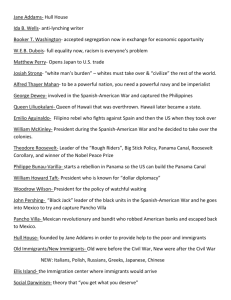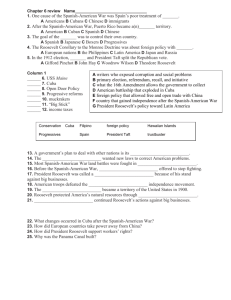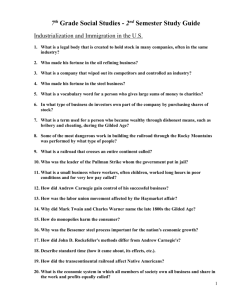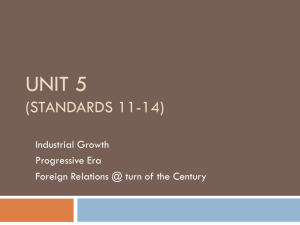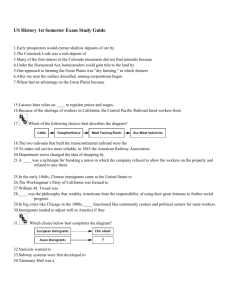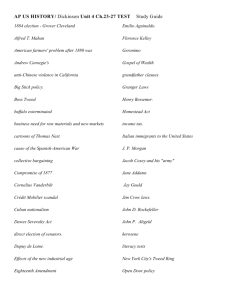Social Studies Midterm Study Guide
advertisement
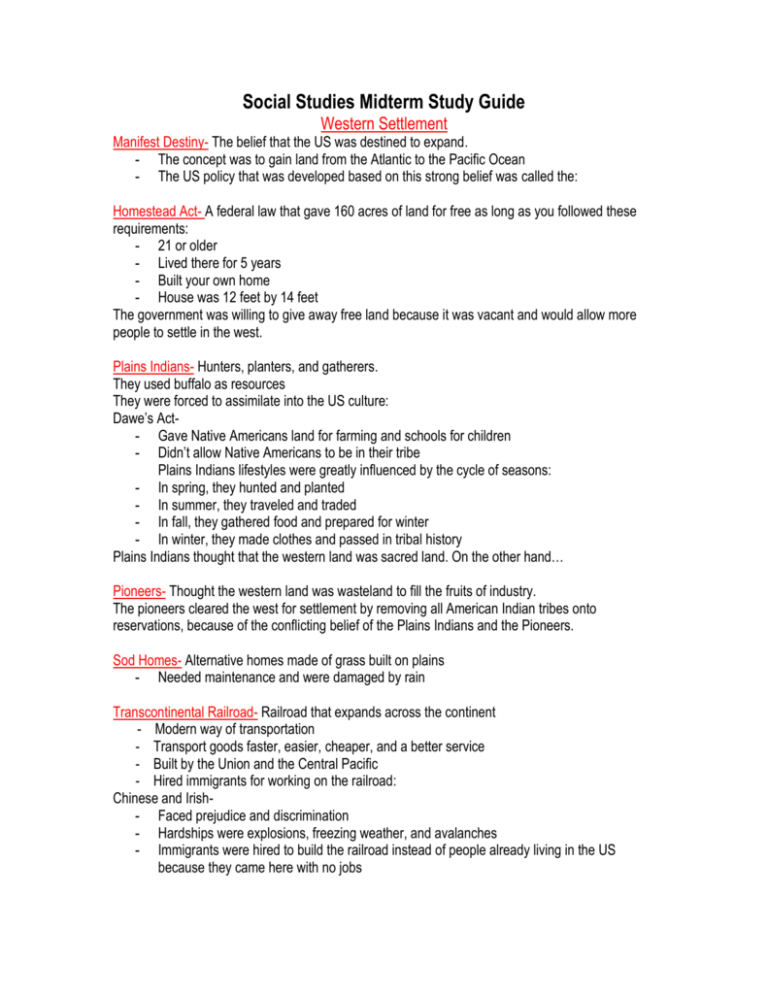
Social Studies Midterm Study Guide Western Settlement Manifest Destiny- The belief that the US was destined to expand. - The concept was to gain land from the Atlantic to the Pacific Ocean - The US policy that was developed based on this strong belief was called the: Homestead Act- A federal law that gave 160 acres of land for free as long as you followed these requirements: - 21 or older - Lived there for 5 years - Built your own home - House was 12 feet by 14 feet The government was willing to give away free land because it was vacant and would allow more people to settle in the west. Plains Indians- Hunters, planters, and gatherers. They used buffalo as resources They were forced to assimilate into the US culture: Dawe’s Act- Gave Native Americans land for farming and schools for children - Didn’t allow Native Americans to be in their tribe Plains Indians lifestyles were greatly influenced by the cycle of seasons: - In spring, they hunted and planted - In summer, they traveled and traded - In fall, they gathered food and prepared for winter - In winter, they made clothes and passed in tribal history Plains Indians thought that the western land was sacred land. On the other hand… Pioneers- Thought the western land was wasteland to fill the fruits of industry. The pioneers cleared the west for settlement by removing all American Indian tribes onto reservations, because of the conflicting belief of the Plains Indians and the Pioneers. Sod Homes- Alternative homes made of grass built on plains - Needed maintenance and were damaged by rain Transcontinental Railroad- Railroad that expands across the continent - Modern way of transportation - Transport goods faster, easier, cheaper, and a better service - Built by the Union and the Central Pacific - Hired immigrants for working on the railroad: Chinese and Irish- Faced prejudice and discrimination - Hardships were explosions, freezing weather, and avalanches - Immigrants were hired to build the railroad instead of people already living in the US because they came here with no jobs Native Americans- Railroad builders showed that they didn’t value the lives and traditions of the Plains by making railroads on Native American land - The completion of the transcontinental railroad lead to the destruction of the Plains Indians’ way of life because many animals were killed from the pollution Benefits for Economy- Easy transfer of goods - Boosted steel production - Created jobs - Industries became larger - Farmers could move cattle quicker and easier Time Zones- Standard time zones were necessary because train schedules were confusing people since they were based on local solar time. - Time zones were based on every 15° longitude (24 time zones) Miners- People who went out west looking to find ores after gold was discovered - Mined for gold and silver throughout west creating boomtowns - Moved on when gold and silver ran out and created ghost towns - Helped develop cities Ranchers/Cowboys- Owners of cattle ranches - Raised cattle in places like Texas, Kansas, etc. to be sold as meat for the miners and people living back east - They would have cowboys lead the cattle on the cattle trails to the cow towns along the railroad lines - It was a profitable method for making money in the West - Led to the creation of Cattle Kingdom The Rise of Industry and Unions John D. Rockefeller- An important person that revolutionized the petroleum industry (oil) and defined the structure of modern philanthropy. He used both vertical and horizontal integration. Offered lower rates to Standard Oil to attract its valuable shipping business. Sometimes Rockefeller got railroads no to provide service to his competitors. Rockefeller used consolidation to cut his costs and formed trusts. This resulted in higher costs for the buyers. Andrew Carnegie- An important person that founded the Carnegie Steel Company. - He was a Scottish immigrant, who built a steel mill in Homestead, Pennsylvania. - He was involved in railroads, bridges, oil industry, libraries, schools and universities. He is most known for his Carnegie Steel Company. In 1873 Carnegie focused his efforts on steel production. He bought out all of his competitors when steel prices were low. - His mills were producing more steel than all of Great Britain’s steel mills combined. He used vertical integration. - Rockefeller spent his profits on rivals, iron mines, railroads, steamship lines, and warehouses. Cornelius Vanderbilt- An important who bought and controlled 4,500 miles of railroads. - Also known as sobriquet Commodore, was an American entrepreneur. - He built his wealth in shipping and railroads and was the patriarch of Vanderbilt family ad one of the richest Americans in history. J Pierpont Morgan- The most powerful banker in the late 1800s who spent banking profits to control major corporations. - From 1894-1898, he had control over more of the nations major railroad lines. - He was the head of the United States Steel Company after buying the Carnegie Steel Company and making a single corporation. - It was the 1st American business worth more than $1 million dollars. - He invested in a stock of troubled corporations. Thomas Edison- An important person that invented a long lasting light bulb, phonograph and a power plant. - This allowed long-lasting vision even in the night for people. - His labratory is located in Menlo Park, New Jersey was called an “invention factory” because it created 100s of inventions, such as a light bulb and phonograph. - He held over 1,000 patents. - He invented a power company to distribute electricity, but could not send it over long distances. Alexander Graham Bell- Is an important person because he invented the telegraph. (1876) - His mom and wife were deaf, profoundly influencing Bell’s work. - This was necessary because before electricity couldn’t light up entire cities. Orville and Wilbur Wright- Important people who invented the plane. - People saw little use for flying machines- wasn’t efficient. - They invented a new method of transportation. - A gas engine powered this. (1903) Henry Ford- Created the assembly line to build a simple, affordable automobile - This led to mass production. - The model T was available to more citizens. George Eastman- Invented the 1st lightweight camera (Kodak) - This made it an instant hit with travelers, the simplicity of operation made it marketable to everyday people. Jan Matzeliger- An important person that invented the shoemaking machine that attached the upper part of the shoe to the sole. - This device created shoes faster than by hand. - This allowed prices to decrease. Samuel Morse- An inventor who reduced the unwieldy bundle of wires into a single Morse code of the telegraph. The telegraph was originally a bulky and impractical machine that was designed to transmit over 26 electrical wires. - It secured funding from congress to build wires across the United States. - It provided a nearly instant means of communication for the 1st time. Knights of Labor- Terence Powderly was the unions President who opened the membership to immigrants, blacks, women and unskilled workers. Immigration Old Immigrants- Came from England, Ireland, Germany, and Scandinavia - Came from Northern and Western Europe - Arrived before 1885 - Most spoke English New Immigrants- Came from Italy, Poles, Greek, Russia, Hungary, India, and China - Came from Southern and Eastern Europe - Arrived in late 1800s - Spoke their native language Reasons for Immigration – Push Factors (out of the country) - Scarce land - Farm jobs lost to new machines - Political and religious persecution - Revolution - Poverty - Hard times Reasons for Immigration – Pull Factors (into the US) - Freedom - Better life - Family and friends already in US - Factory jobs - Plenty of land - Political stability Ellis Island- Created in 1892-1954 - Located in New York Harbor - Created to process third class and steerage immigrants - Processed European immigrants Angel Island- Created in 1910-1940 - Located in China Cove, California - Created to control the flow of Chinese people into the country - Processed Asians Melting Pot Theory- People from various cultures come to America and contribute aspects of their culture to create a new, unique American culture - Result - contributions from many cultures are indistinguishable from one another and are effectively “melted” together Salad Bowl Theory- Newly arrived immigrants do not lose the unique aspects of their cultures like in the melting pot; instead they retains them - The unique characteristics of each culture are still identifiable within the larger American society, yet contribute to the overall make up of the salad bowl Nativism- To keep out immigrants and have America as a native-born Americans only country. Reasons why Nativists want to limit the number of immigrants who entered the US- Took jobs for low pay - Felt the newcomers would not assimilate because their languages, religions, and customs were too different - Americans did not understand new immigrants culture Effects of Nativist Feelings- Disagreements - Violence - Racism - Discrimination RestrictionsChinese Exclusion Act- Banned almost all Chinese immigration and did not allow Chinese people to become citizens Gentlemen’s Agreement- Between US and empire of Japan US cannot restrict Japanese immigration and Japan would not allow Japanese emigration to the US Emergency Quota Act- Limited the number of people that came from a country Immigration Act of 1924- Limited the number of East Asians, Asian Indians, and Southern and Eastern Europeans Urbanization- Rapid growth bring many problems Cities Boom- As industries grow more and more factories are built in the cities - More factories = more jobs - People from across the US and around the world flock to cities looking for work: farmers from the west, African Americans from the South, and immigrants The Wealthy- Seeking to avoid the crowded sections of the cities, the wealthy live in exclusive neighborhoods far from the filth of the “inner city”. Tenement Life- Unable to afford much, most people arriving in cities are forced to live in crowded rundown building called tenements in crime-infested neighborhoods called slums Settlement Houses- People like Jane Addams established community centers to aid the needy - Hull House is the most famous of these centers Social Gospel- Many people (especially the middle class) begin to believe it is their “Christian Duty” to come to the aid of the poor. This inspires them to push for reform and to provide direct aid to the poor - Managers are urged to pay workers enough to get married - Mother Cabrini helps to open 70 hospitals for the poor - The Salvation Army spreads Christian teachings and provides food and shelter - YMCA, YWCA, and later the YMHA Building Codes- Buildings must pass inspections - Factories and living areas are kept separate - Cities create fire departments - Sanitation workers collect garbage - In the largest engineering project since the pyramids, New York City has a tunnel dug 100 miles from Manhattan to the Catskill Mountains for fresh water City Life Transformed- Over time, most workers enjoy less work hours and slightly more pay. This creates a new concept in American history for the working class…leisure time - Vaudeville: a stage performance featuring dancing, music, acrobats, and comedy - Sports: Baseball, boxing, and college football are the most popular attractions in America - Reading becomes leisure - Dime Novels: cheap books about cowboys, detectives, and rags-to-riches stories (Horatio Alger) - Yellow Journalism: as competition for readers increases, newspapers invent more and more exaggerated headlines (Joseph Pulitzer and William Randolph Hearst) - New Music - Ragtime: composers like Scott Joplin create lively piano music for dancing - March: John Philip Sousa and others create rousing military-like music for marches and parades Living Conditions of Poor Immigrants: Tenements- Crowded - Extremely hot or cold - Dirty - Fire Hazards - Small - No light - Messy - Smelly - No bathroom - Unsafe (fire - Skinny Hallways Progressive Era Progressives- reformers, forward thinking people who wanted to reform American life The Spoils SystemUsed wisely in government politics Rewarding jobs to those who either supported you with money or votes during a candidate’s campaign Rewarding jobs is also known as patronage Gave jobs to people who were unqualified for the position James Garfield was assassinated by Charles Gaiteau because he was not rewarded with a job by the Spoils System City and state governments were corrupt Corruption led to reform Robert LaFollette and the Wisconsin Idea- Robert La Follette aimed to end political corruption and pushed to replace the spoils system with a system that appointed government jobs based on merit, called the civil service reform. One of the first states to adopt progressive reforms Nickname “Fighting Bob” Commissions of experts to solve political corruption Opposed the power of party machines and corporations Direct primary elections and campaign spending limits Created state commissions to regulate government and industries Lowering railroad rates The 16th and 17th amendments were reforming The Pendelton Act- Creates the Civil Services Commission in 1883 Civil Services Commission includes most government jobs, except elected positions, judiciary and the military Jobs were to be filled based on merit Jobs would go to those who scored highest on service exams Progressive Political Reforms- gave voters more power. Interstate Commerce ActThe interstate commerce commission controlled railroad rates and trade across states The act was NOT affective towards controlling railroads Sherman Antitrust Act: In regards to the act, judges would usually rule in favor of big businesses This act was used against labor unions to prevent strikes It eventually became effective for breaking up monopolies Teddy Roosevelt- A trustbuster who wanted to reform unfair practices of natural monopolies like the railroads. - The “Square Deal”, the difference between good and bad trusts according to Roosevelt, was that good trusts provided good products and services at a reasonable price but bad trusts tried to take over and create monopolies Believed that fair trusts should be left alone but bad ones that cheated to public should be broken up Roosevelt got the name “trustbuster” by breaking up the J.P. Morgan Northern Security Corporation and more. Roosevelt took action to pass the Pure Food and Drug Act because Workers- Conditions were very dangerous, crowded, and unsanitary - Workers demanded short work weeks, better wages, improved working and safety conditions - The mine owners and workers got a “Square Deal” because they made a compromise for workers not going on strike for 3 years and the mine owners give them what they demanded. President Taft- Trustbuster - Roosevelt didn’t want to run for reelection in 1909, so he supported his Secretary of War, William Howard Taft, who won the election. (Roosevelt goes to Africa) - Taft was quiet and careful; feared power - Supported many progressive reforms: - Broke up more trusts than Roosevelt - Approved safety regulations for workers - Department of Labor set up bureau to deal with problems of labor - Lost support when he approved a tariff that raised prices for consumers and when he fired the Chief of the US Forest Service during a dispute over the sale of wilderness area Bull Moose Party - Roosevelt returns from safari in Africa to find Taft’s failing reputation with reformers - Roosevelt ran for president again, but lost the Republican nomination - Progressive Republicans formed a new party called the Bull Moose Party President Wilson - Roosevelt and Taft had more votes than Wilson, but split their party – Woodrow Wilson wins the election - Wilson was a brilliant scholar and a cautious reformer - New Freedom- want to break up monopolies into smaller pieces to restore competition - Federal Reserve Act (1913) – set up a nationwide banking system. It gave the federal government the power to 1. Establish federal reserve banks across the country 2. Control the amount of money in the circulation and interest rates 3. Shift money from bank to bank as needed - Regulating Competition: - Federal Trade Commission (FTC) – 1914, power to investigate companies and order them to stop using business practices that destroyed all competitors - Clayton Antitrust Act- strengthened the Sherman Antitrust Act and banned some business practices that limited competition. Stopped antitrust laws from being used against unions Imperialism Imperialism- Expanding politically, economically, and territorially. - Social: Social Darwinism, Racism (White Man’s Burden) - Political: Protecting American interests and citizens abroad, Securing the Western Hemisphere - Economical: The search for new marketplaces, Foreign Trade Manifest Destiny- The belief that the US was destined to expand. The Purchase of Alaska- Secretary of State William Seward under President Johnson arranged for the purchase of Alaska from Russia in 1867 - Many Americans believe it is a bad idea, even for only 2 cents an acre, the deal is labeled as “Seward’s Folly” (Folly: MISTAKE) - Settlers eventually discover that Alaska is rich in natural resources and minerals and it certainly was not a folly Acquisition of Hawaii- Hawaiians lived on the islands of Hawaii for more than a thousand years, they had a monarchy, with their own kings and queens - American planters had established sugar and pineapple plantations on the islands and did not want to pay a tariff for importing their cash crops into the US - Native Hawaiians under the rule of Queen Liliuokalani began to protest American presence, they began calling for “Hawaii for Hawaiians” - American planters feared they would lose their land and with the help of US marines, Queen Liliuokalani was dethroned - Under President McKinley, the US did annex Hawaii in 1898 JapanThe Opening of Trade With Japan- US seeks to open new markets in Japan - Japan has closed its doors to outsiders with a policy known as isolation, and it restricted foreign ships to a small part of Nagasaki Matthew Perry and the Opening of Japan - Commodore Matthew C. Perry, commander of the US naval forces in the China seas - In 1853, President Fillmore ordered Perry to open trade negotiations with the emperor of Japan American Influence in Japan - Perry impressed the Japanese officials with his diplomacy and with the superiority of his ships and weapons - Japanese officials eventually give in to pressure and sign the Treaty of Kanagawa in 1854, which opens up Japan ports to US Ships - His diplomatic mission has officially established the United States’ presence in Asia ChinaSpheres Of Influence in China- Opium Wars had left China at the mercy of European powers - Chinas was carved up into “spheres of influence” - Spheres of Influence: a territorial area within which a foreign nation has a major economic and political influence America’s Open Door Policy- The US demanded equal trading status within China, and rather than carving out its own sphere of influence, it simply announced the Open Door Policy in 1899 - Open Door Policy: all nations should have equal trading rights regardless of spheres of influence The Boxer Rebellion- Growing fear that the Chinese would be reduced to servants of the western powers, the Boxers saw anything Western as evil and used traditional martial arts - After the Open Door Policy Chinese nationalists, called Righteous Harmonious Fists, staged the Boxer Rebellion in 1900 (Boxer = Kung Fu) Imperialist Response to Boxer Rebellion- The Boxer Rebellion was viewed as a threat to the profits that Western powers enjoyed in their imperialist spheres of influence - The foreign nations formed an international coalition that ending the uprising Spanish-American War Causes of the Spanish-American War- Cuban Revolution: Spanish tried to control Cuban rebels calling for independence - Yellow Journalism: William Randolph Hearst’s major publication was the New York Journal and Joseph Pulitzer’s The New York World were in competition to sell newspapers The US sent ships to Cuba to act as “peace-keepers” between Cuba and Spain. The US Wins The Spanish-American War- Sinking of the USS Maine: The US warship USS Maine was stationed in the harbor of Havana, Cuba when it exploded, killing over 260 Americans - Motivation for Blaming the Spanish: American leaders that wanted to expand America’s economic influence recognized that defeating a weak Spanish Empire was an opportunity to gain territories and access to world markets outside of North America Battles of the Spanish American War- The Pacific Theater of the Spanish-American War- Took place at Manila Bay, Philippine Islands - George Dewley was in charge of the US Navy squadron that destroyed the Spanish fleet in Manila Bay on May 1st, 1898 - The US Battleships sailed from Hong Kong - The Caribbean Theater of the Spanish-American War- Took place at Puerto Rico and Cuba - US battleships sailed from Tampa, Florida - The US defeated the Spanish by forming a blockade with battle ships - The US Navy was so important because they cut off supply lines and most battles on water - Battle of San Juan Hill - Teddy Roosevelt did not intend to miss his chance at glory. Roosevelt resigned as Assistant Secretary of the Navy and formed a volunteer regiment of cavalry to fight in the Spanish-American War - Roosevelt’s cavalry division knows as Rough Riders and the Ninth Cavalry, an African American regiment, were responsible for a major victory at the Battle of San Juan Hill. Roosevelt returned home a war hero. Because of his bravery in battle, he was nominated for the Congressional Medal of Honor The Results of the Spanish-American War- Majority of American casualties in war was caused by infection and disease - Other American casualties were killed in combat US Benefitted from Spanish-American War- Treaty of Paris- signed by Spain in December of 1898 - Ceded Puerto Rico and Guam to the US - Granted US independence (Cuba becomes protectorate) - Sold the Philippines to the US for $20 million Governing the New Territories- Puerto Rico- Foraker Act of 1900 - Allows Puerto Ricans to elect legislature (Puerto Rico is a possession of US) - US appoints the governor - Us appoints the council - Cuba- Platt Amendment (1901) - Cuba maintains its independence as a nation - US must approve treaties between Cuba and other nations - US has right to lease naval bases in Cuba - US may intervene in Cuba to preserve order and peace (US is protectorate) - Philippines (American-Filipino War 1899-1902) - Emilio Aguinaldo, who has been fighting the Spanish for Philippine independence, resisted annexation by the US and declares the Philippines a republic - Aguinaldo felt betrayed by the US that he fought alongside during the SpanishAmerican War and were now doing the same thing Spanish had done - US-Filipino War lasted nearly 3 years, it claimed over 4,000 Americans (The Spanish-American War was ten weeks and resulted in less than 400 battle deaths) - The war ended with the capture of Aguinaldo, The Philippines remained under the US control until World War I - Vs. Imperialist US needs colonies to compete economically To be a world power, US needs colonies and naval bases To abandon territories made the US appear cowardly before the world It is only honorable to keep land that Americans lost their lives to obtain - Anti-Imperialist Supporting an empire is very expensive The US should concentrate on solving the many problems at home An empire would involve the US in more wars It is a violation of democratic principles to annex land and not offer its people the same rights as those of US citizens
